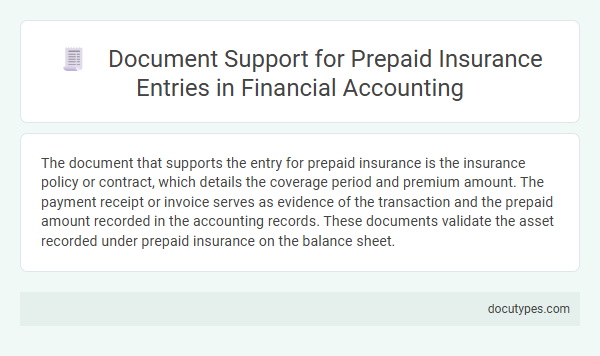The document that supports the entry for prepaid insurance is the insurance policy or contract, which details the coverage period and premium amount. The payment receipt or invoice serves as evidence of the transaction and the prepaid amount recorded in the accounting records. These documents validate the asset recorded under prepaid insurance on the balance sheet.
Introduction to Prepaid Insurance in Financial Accounting
Prepaid insurance is an asset that represents insurance premiums paid in advance for coverage over a future period. The document that supports the entry for prepaid insurance is the insurance policy or premium invoice received from the insurance company. You use this document to record the prepaid insurance in your financial accounting system, ensuring accurate expense recognition over time.
Importance of Document Support for Prepaid Insurance
| Document Type | Purpose | Key Details | Importance for Prepaid Insurance |
|---|---|---|---|
| Insurance Policy | Provides official terms and coverage details of the prepaid insurance | Policy number, coverage period, premium amount | Validates the prepaid expense by confirming the insurance coverage period and premium cost |
| Payment Receipt | Proof of payment for the prepaid insurance premium | Payment date, amount paid, payer information | Confirms the transaction and amount credited as prepaid insurance |
| Invoice from Insurance Provider | Lists the billed amount for prepaid insurance services | Invoice number, billing date, premium details | Supports the recorded prepaid insurance amount and matches it with company records |
| Journal Entry Documentation | Records the accounting entry for prepaid insurance | Date of entry, debit to Prepaid Insurance, credit to Cash/Bank | Ensures transparency and accuracy in financial records related to prepaid insurance |
| Amortization Schedule | Details allocation of prepaid insurance over the coverage period | Monthly or quarterly expense allocation | Demonstrates the systematic expense recognition and supports ongoing adjustments |
Types of Documents Used for Prepaid Insurance Entries
Prepaid insurance entries in financial records are supported by specific documents that verify the payment and coverage period. These documents provide essential details to ensure accurate accounting treatment for prepaid expenses.
Common types of documents used for prepaid insurance entries include insurance policies, payment receipts, and invoice statements from insurance providers. The insurance policy outlines the coverage period and terms, serving as proof of prepaid coverage. Payment receipts and invoices confirm the amount paid and the date of transaction, helping you accurately record the prepaid insurance in your accounts.
Invoice Verification for Prepaid Insurance Recognition
Invoice verification plays a critical role in recognizing prepaid insurance entries in financial records. Accurate documentation ensures that prepaid insurance amounts are properly recorded as assets until they are expensed.
- Invoice - Serves as the primary document confirming the payment and details of the prepaid insurance policy.
- Payment Voucher - Verifies the transfer of funds relevant to the prepaid insurance, supporting the invoice.
- Insurance Policy Schedule - Provides detailed coverage periods to allocate insurance expense accurately over time.
Recording Prepaid Insurance: Required Documentation
Recording prepaid insurance requires specific documentation to validate the transaction. The primary document supporting the entry for prepaid insurance is the insurance policy or invoice detailing the coverage period and payment terms.
These documents provide proof of payment and the insurance period covered, essential for accurate accounting. Maintaining the original insurance policy or invoice ensures compliance during audits and financial reviews.
Audit Trail and Compliance in Prepaid Insurance Entries
Which document supports the entry for prepaid insurance? The primary document supporting the prepaid insurance entry is the insurance policy or premium payment receipt. These documents create a clear audit trail ensuring compliance with accounting standards and internal controls.
Document Retention Policies for Prepaid Insurance
Prepaid insurance entries are supported primarily by the insurance policy and payment receipts. Proper document retention policies ensure these records are maintained for audit and compliance purposes.
- Insurance Policy - Serves as the primary evidence of coverage period and payment terms.
- Payment Receipts - Confirm the actual payment amount and date for the prepaid insurance.
- Retention Duration - Documents should be retained according to financial regulations, typically 5 to 7 years.
Maintaining accurate and accessible prepaid insurance documentation supports transparent financial reporting and audit readiness.
Common Errors in Documenting Prepaid Insurance
The document that supports the entry for prepaid insurance is the insurance policy contract or the related premium payment receipt. Common errors in documenting prepaid insurance include failing to record the prepaid amount correctly in the asset account and neglecting to adjust for the insurance expense over the coverage period. These mistakes can lead to inaccurate financial statements and misrepresentation of company assets.
Best Practices for Document Management in Prepaid Insurance
The document that supports the entry for prepaid insurance is typically the insurance policy or premium invoice issued by the insurance provider. This document serves as proof of payment and the coverage period, essential for accurate accounting records.
Best practices for document management in prepaid insurance include organizing these documents chronologically and storing them in a secure digital system for easy retrieval. You should regularly review and reconcile these records to ensure accuracy in financial statements and audit compliance.
Which Document Supports the Entry for Prepaid Insurance? Infographic

